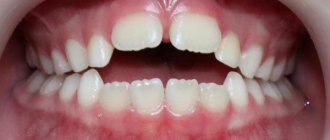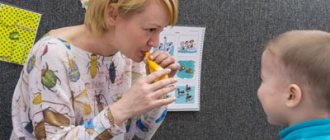For many parents, the day separating the first year of a child’s life from the second is a kind of milestone for summing up the results. They closely analyze the achievements of their children’s peers, comparing them with what their child can do and are worried if they notice a lag behind the norm. Of particular concern is the fact that a child does not speak at one year of age.
Let's figure it out, is it really important to worry if a child hasn't uttered a word in a year? When should you worry about speech delay? What can be done in advance to ensure that a one-year-old baby’s speech corresponds to the norm?
Between normality and pathology
No one needs to prove the importance of timely mastery of their native speech. This is a complex, multifaceted process directly related to various mental functions: attention, thinking, memory and speech. They expect the first words from a one-year-old baby, but he cannot even say “dad” and “mama”, he babbles in his own language and is not going to learn new words.
Alarmed parents begin to study family history, turn to doctors for advice and do their best to speed up the speech development of the baby.
A one-year-old child is able to pronounce from 3 to 12 words, but in their structure they are simple, very similar to babbling. Woof-woof, beep-bee, am-am, lalya, give, dad, mom, baba, kitty, na, bang or whoop - this is the approximate vocabulary of children per year.
Each baby is individual - some develop their first word at 8–9 months, and others at 1 year 3 months, and all these are variations of the norm.
Before the appearance of the first word, the speech of a one-year-old child went through a complex path of development. The laws of the formation of children's speech do not change over time. Today, like 100–200 years ago, not a single baby begins to speak in words and sentences until he has gone through all the stages of speech development. These stages are associated with the development of the brain, articulation apparatus and hearing.
No early development method can change the laws of nature, according to which the organs of pronunciation (articulation), hearing and the central nervous system of a person develop.
If you are concerned that your baby speaks poorly, check out the main stages of pre-language development in children under one year of age:
- 1–2 months – the appearance of intonations of pleasure and displeasure in the cry;
- 1.5–3 months – humming or hooting, when children repeat after adults vowels with the sound [g] or pronounce them independently, carefully listening to the sounds they pronounce (agu);
- 4–5 months – babbling, pronunciation of similar words consisting of several identical syllables (ma-ma-ma, but this does not yet mean the word mom);
- 8–9 months – appearance of onomatopoeia (pee-pee, woof-woof) and babbling words (kuka, tata, nanny);
- 11 months – the child uses approximately ten babbling words in the correct context, correlating their pronunciation with the situation (mom, dad, dai, bibi, etc.).
What is considered pathology? It is still too early to make predictions about speech development at one year old, however, you should start to worry if a one-year-old baby does not understand simple verbal instructions that are not supported by gestures. For example, “Give me the ball”, “Show me where the car is”, etc. Lack of response to an adult's words may be a symptom of hearing impairment or its complete absence. In this case, speech stops at the humming stage, because the child has nothing to relate his own babble to.
If urgent measures are not taken at this stage, it will be very difficult to stimulate speech development in the future. It is important to promptly contact an otolaryngologist for a hearing test. Perhaps, in case of pathologies of the inner ear, the doctor will consider it necessary for the child to wear a hearing aid. In case of serious hearing deviations from the norm, this is the only opportunity to develop and maintain speech.
Signs of possible hearing loss
| End of 1st month | In response to an unexpected and loud sound: there is no inhibition of general motor or sucking movements, does not flinch, does not blink. |
| End of 2nd month | Does not listen to the ringing of a bell (at a distance of one and a half meters). |
| End of 3rd month | Doesn't look for the object that makes sounds with his eyes, doesn't turn his head to the right, left or towards the source of the sound. Does not respond to musical toys. |
| End of 5th month | Doesn't stop crying when he hears music or his mother singing. |
| End of 6th month | Does not react to the rustling of paper that is outside his field of vision. |
| End of 7th month | Does not turn towards the sound source or the person speaking. Doesn't smile when you talk to him. |
| End of 8th month | Does not listen to adults' conversations. Doesn't freeze when hearing a new sound. Shows no interest in music. Doesn't babble. |
| End of 9th month | Doesn't respond to his own name. Doesn't understand the word "no" or prohibition. Doesn't play "talk" with you. |
| End of 10th month and 11th month | Babbling is either absent or “monotonously” colored. Doesn't use his voice to attract attention. |
| End of 12th month and older | At the request of an adult, does not point at people or familiar objects. Does not imitate simple sounds and monosyllabic words. Does not respond to quiet sounds made outside his field of vision. Does not turn his head towards the source of sound (both quiet and loud). Doesn't understand simple calls. Shows no interest in everyday sounds or music. Doesn't try to talk. |
You should definitely contact an audiologist if:
- You notice the signs of hearing loss described above in your baby;
- A whitish or yellowish fluid is discharged from the child's ear. In such cases, the baby does not always show anxiety or complain of unpleasant or painful sensations. However, such discharge may indicate inflammation of the middle ear;
- The child grabs his ears, hits them, rubs them and cries. The cause of this condition may be an infectious disease that requires immediate treatment. Otherwise, this may lead to irreversible damage to the organ of hearing;
- The baby covers his ears and cries when he hears an overly loud sound.
Possible reasons for delayed speech appearance per year
If the baby is completely healthy, there is no history of neurological diseases, but speech has not appeared at one year, most likely the reason for the delay is in an improperly organized speech environment.
What is meant by this term? It would seem that modern children are surrounded by a real stream of speech: TV, radio, cartoons, audio books and educational games for the youngest children. And parents talk a lot with their children.
The fact is that young children are not able to isolate individual words from a stream of speech. If no special purposeful work is carried out, this flow for a child sounds approximately the same as the sound of a waterfall sounds for us.
Today, speech games (Magpie-Crow, Ladushki), nursery rhymes, pestushki, songs, sayings, previously known in every family, have disappeared from everyday life. These unique simulators gently introduced the baby into the world of native speech. They were adapted to the needs of a child up to one year old, contained onomatopoeia, and were understandable to children.
Another factor in the “nutrient” environment for the development of children’s speech is communication with the mother. A silent mother or a mother who talks on the phone more often than with her own baby will not be able to replace the value of communication, which forms the speech structures of the brain, with the best educational games.
“Mowgli’s children”, “hospitalism” - all these terms denote a delay in the appearance of speech in healthy children who are deprived of the opportunity to communicate with loved ones due to their absence.
How to check if your baby can hear?
The sounds that surround us in everyday life, including the sounds of speech, have different volumes and different frequencies. The volume of sounds in acoustics is measured in Decibels, and the sound frequency is measured in Hertz.
Depending on their physical characteristics, sounds are:
- low-frequency - the sound of a passing truck, the sound of a jackhammer, and in speech - the sound [n], [m].
- mid-frequency - the sound of a piano, the cry of a baby, and in speech - the sounds [p], [g].
- high-frequency - rustling leaves, birdsong; speech sounds - [c], [f], [ts].
When hearing loss occurs, a person's ability to perceive sounds of certain frequencies, primarily high-frequency sounds, is reduced.
To conduct the examination you must prepare:
1) Three identical film cans, or Kinder Surprise capsules. Pour one third of semolina into jar No. 1, buckwheat into jar No. 2, and peas into jar No. 3.
2) You will need a squeaky toy, which your baby probably has. In the study you will conduct, the squeaky toy is a high-frequency sound stimulus, and the cereal boxes produce sounds at different volume levels:
- semolina - approximately 30 - 40 dB;
- buckwheat - approximately 50 - 60 dB;
- peas - approximately 70 - 80 dB.
Getting rid of the disorder
Recognizing the symptoms of childhood mutism and treating it poses some challenges. To establish a diagnosis, it is necessary to clearly differentiate the phenomenon from other disorders.
There is no generally accepted treatment regimen for mutism in children. An individual approach is used in each specific case. Possible methods used:
- psychotic drugs to relieve tension, relieve fear;
- physiotherapy to relax the muscles of the neck and speech-motor apparatus, which the child strains in the situation of planned communication;
- psychotherapy. Initially, individual therapy is recommended to establish contact with the little silent one. But in the future, you should still switch to the group form. Being in a team helps to establish social contact and emancipation. Group therapy may take the form of drama. Family psychotherapy is required.
But it is worth understanding that the main step to restoring a child’s speech activity is treating the underlying disease or eliminating a traumatic psychological factor. Therapy must be started as early as possible. The following situations may be indications for contacting a doctor:
- if the baby does not communicate for more than 1 month;
- the presence of speech problems under certain circumstances;
- the child hears and understands what is said to him, his intelligence is preserved. Tries to communicate with gestures and writing;
- absence of speech motor defects.
Children suffering from mutism are a special category. Despite their silence, they understand everything, are distinguished by observation and simply donkey stubbornness. The inability to speak creates tension and unrest in their inner world. They are able to swim in different guises. For example, cases of pronounced cruelty in children have been observed. The boy could come up to his mother and bite her for no reason. Other patients showed cruelty to animals.
The inability to express one's thoughts directly requires treating silent people with increased attention. Early diagnosis and assistance to the child will help to avoid social vacuum and psychosis.
How to help a child?
It is worth understanding that these habits do not arise on their own and not because of bad behavior. Comments and reminders that you should not stick your tongue out will not work - you need to work with the root cause of the disorder.
- Restore nasal breathing.
Orthodontists often prescribe consultations with an otolaryngologist, since the dental system and respiratory organs are closely connected. Removal of adenoids, treatment of chronic diseases, normalization of the microclimate at home to reduce the frequency of acute respiratory viral infections, hardening and other restorative procedures - all this can be prescribed by a doctor to achieve remission.
ENT can help restore health for proper tongue function
- Contact an orthodontist.
Only in this order, otherwise the treatment will not be effective. As soon as the child is able to breathe with his mouth closed, you can move on to correcting the position of the teeth and tongue.
For this purpose, children's orthodontic devices have been created:
- Plates.
- Trainers.
- Twin Block device.
- Children's aligners Kinder Smile.
All these devices are removable and act quite gently, guiding teeth during the period of their active growth. Wearing requires parental supervision, but with proper use, problems are solved quite quickly - within a few months.
Only after this can you begin classes with a speech therapist - when the malocclusion and the main manifestations of tongue dysfunction are eliminated, the correction of sound pronunciation will be much more successful.
Tongue, nose, throat: everything is interconnected
The inside of a child’s nasopharynx is covered with mucous membrane, which should normally perform a protective function: trap viruses, bacteria, dust particles and other allergens. But if the mucous membrane dries out, it becomes too thin and vulnerable.
Therefore, by the way, the child’s room should be cool and fairly humid.
If the house is hot, the air is dry, the mucous membrane of the nasopharynx dries out, and any virus can easily penetrate through the thinned protective barrier. This causes frequent acute respiratory viral infections associated with a runny nose and swelling of the nose.
Due to these diseases, the child’s nasal breathing is impaired, his mouth is constantly open and his tongue is visible. Gradually, the habit of breathing through your mouth in your sleep arises.
Breathing through your mouth during sleep is a very alarming sign
The mouth opens slightly, expanding space for the tongue. And, of course, the child's tongue begins to take up this additional space in and outside the mouth.
This is how tongue dysfunction arises, then it becomes fixed in the child’s habits.
A vicious circle arises: frequent ARVI - stuffy nose - habit of breathing through the mouth - dry mucous membrane - frequent ARVI, and in addition, tongue dysfunction occurs.
All this can lead to the proliferation of lymphoid tissue, and therefore to adenoiditis and tonsillitis, since it is the nose that filters the air, and when breathing through the mouth, allergens and viruses enter directly into the oropharynx. In this case, the blood is not fully saturated with oxygen and sleep at night is disturbed - in the morning the child gets up sleep-deprived, feels drowsy during the day and cannot concentrate on studies.
Please note: when a child sleeps with his mouth open, this is a very alarming symptom. This habit easily passes into adulthood: snoring, apnea and numerous negative consequences from this occur.










